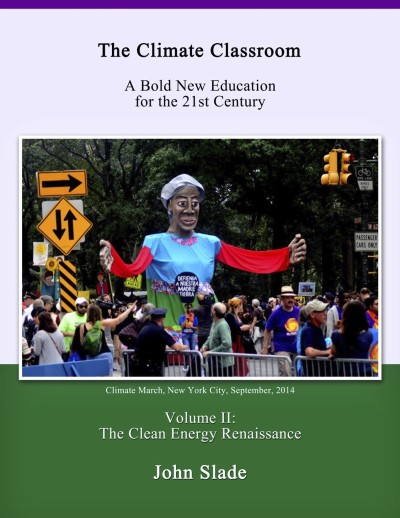
The Climate Classroom: Volume II: The Clean Energy Renaissance
See Volume I: The Climate Crisis
The two volumes are a guide for teachers and students
as they create two vibrant courses
for the autumn and spring semesters.
These courses, adapted to grade school, high school, and university,
will enable students and their communities around the world
to rise to the great challenges of the 21st century.
What if . . . we freed ourselves from the shackles of the 20th Century
—the poverty, the pollution, the plundering, the racism, and the wars—
and together, around the planet,
built the Renaissance of the 21st Century.
* * *
The Climate Classroom:
A guide for teachers and students in the 21st Century
The most neglected energy resource on planet Earth today is the enormous but untapped energy of the young people around the world.
They are deeply aware that they have inherited, through no fault of their own, a severely polluted planet, a steadily warming planet, a dying planet. They are also fully aware that the older generations have done little to curtail the steadily growing amount of carbon dioxide released into the atmosphere.
CO2 levels continue to rise, temperatures continue to rise, ocean acidity continues to rise, sea levels continue to rise, the number of wildfires continues to rise, the number of extinct species continues to rise, the number of climate refugees continues to rise, while political parties bicker with each other, and the pointless wars go on and on.
The young generation around the world, despite their various cultures, share a deep and unrelenting fear, which is growing. They share a deep and unrelenting anger, which is growing. They also share a feeling of helplessness, for they do not control the government, the economy, the military, or even their own schools.
They are not being educated to rise to the great challenges of the 21st Century. Instead, they are provided with superficial classes called Environmental Studies, which are tacked on to various science courses so that the schools can say that at least they are Doing Something.
The schools of the world are still back in the 20th Century, preparing students for a job, whereas the students of today need an education which will enable them to restore the health of their dying planet, so that they and future generations can not only survive, but flourish.
Thus the young people feel helpless, and alone, with little sense of purpose in their lives. They are fed unrelenting entertainment on all of their media gadgets, much of it fantasy, so that they can escape into another world. But the wizards and the aliens and the magic swords and the enchanted rings do little about the rising levels of carbon dioxide and methane in every breath that we take.
* * *
To tackle the great challenges of the 21st Century, students need a new approach to education, one which goes far beyond what is available in most classrooms today. The Climate Classroom is a guide for teachers and students who are looking for concrete steps toward a future filled with hope and purpose.
During the autumn semester, students become thoroughly engaged with The Climate Crisis: the Problem. And during the spring semester, they brim with hope and determination as they explore The Clean Energy Renaissance: the Solution.
These two courses, equal in weight to the other major courses in the curriculum, will go far beyond the old pattern of read the text, listen to the lecture, take the exam. The teacher and students together will invite a series of guest experts to speak in the classroom: farmers who have watched their crops wither as droughts scorch their fields, a meteorologist who can explain weather patterns, a medical expert who can speak about the medical dangers of a warming planet, and a clean energy engineer who can describe the enormous progress that we are already making as we harness the sun and the wind.
A major innovation in both courses will be the research done by the students themselves. The oil companies fooled us by lying to us for decades about the dangers of burning oil. We must never let that happen again. By doing their own research, students learn how to dig deep for their own answers, in the library and online. They become experts at research, a skill that will benefit them for the rest of their lives.
They will write a growing number of three-page essays, based on their research, thus developing their professional writing skills. And they will make ten-minute oral presentations to their classmates, thus sharing what they have learned.
At the end of each semester, the students will organize an all-day conference to which they invite the members of their community. On a Saturday in December, and on a Saturday in May, students will share their bounty of knowledge with hard-working adults who perhaps have not had enough time to fully understand the importance of the melting of the Arctic ice cap, or the weakening of the jet streams, or the opportunities for powering their home town with 100% clean energy within the next ten years.
Every graduating class can make a contribution to their school—with another dozen solar panels on the roof, with a wind turbine at one end of the football field—until the school is powered with 100% clean energy.
* * *
On the global level, a day in the classroom becomes even more exciting. We are going to weave our schools together all around the planet, so that students who live near the wildfires in California can work together with students who live near the wildfires in Siberia and Spain and Indonesia and Australia and the Canadian Arctic. We’re going to weave our schools together so that students who have been blasted by hurricanes in New Orleans and New York City and on islands in the Caribbean can work together with students who have been blasted by typhoons in Indonesia and the Philippines and China and Japan. We’re going to enable students to skype with each other, so they can share their research about drought and the collapse of agriculture, about new cases of malaria, and about water desalinization plants powered by both solar and wind power.
The students will also share their music, and their poems, and their hope.
We’re going to weave a network between schools and clean energy companies around the world. Professional engineers and eager apprentices will explore global solutions to global problems. Students will benefit because they are working toward future jobs, future lifetime careers, and the companies will benefit because they are training future workers, future visionaries.
We will also weave a vibrant web between the schools of the world and the Indigenous peoples of the world. The Sami people, who have herded their reindeer on the Arctic tundra for thousands of years, have a far deeper understanding of snow, and the seasons, and the health of mountain lakes, and the migration of salmon, than the dreary politicians in Oslo with their latest regulations on the size of reindeer herds. We must listen to the native peoples who have lived on the land for centuries. They are the teachers who have been too long ignored.
Students and experts together will create an online Climate Library which focuses on the twin themes of the climate crisis and clean energy. Students in a small, remote school will have access to state-of-the-art information in a growing number of languages. The library will of course be free for anyone to use.
As local schools organize a climate conference for their communities, so shall the students of the Global Classroom meet every few years for regional conferences, and global conferences.
Their discussions of climate issues will no doubt develop into discussions about new economic systems, new legal systems, and new political systems. Some of the students, in this First Global Generation in Human History, will emerge as the leading scientists, engineers, economists, lawyers, statesmen, and writers of the 21st Century. Students become colleagues, who become a professional generation able to launch the Renaissance of the 21st Century.
* * *
In addition to everything else, students will find their purpose. As they do their own research, they will feel a growing sense of empowerment, and purpose. As they find their way toward a career which excites them, their sense of purpose will grow. And as they see that yes, they are contributing toward building a far better world, that passionate purpose will motivate them for the rest of their lives.
* * *
The Climate Classroom does not serve as a comprehensive text book, but as a springboard for further research, and for great classroom discussions.
No quiz. No exam. Your exam is the next sixty years of your life.
* * * * *
John Slade
PhD in literature, Stanford University, California.
Teaching career on the high school and university levels:
In California, Illinois and New York,
on the island of Saint Croix in the Caribbean,
for ten years above the Arctic Circle in northern Norway,
including three years in the heart of the tundra with the indigenous Sami,
And in universities in Saint Petersburg, Murmansk, and Arkhangelsk, Russia.
Book categories: Climate Change and Clean Energy
